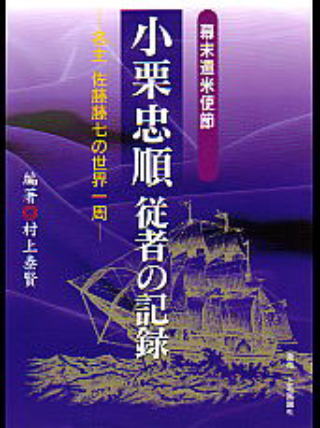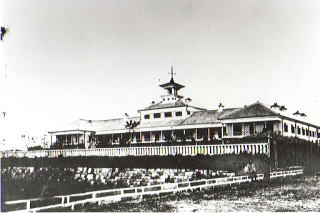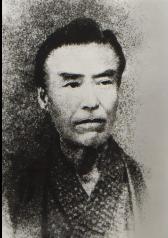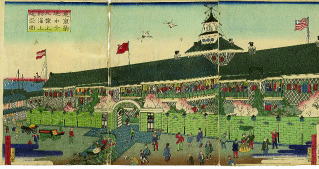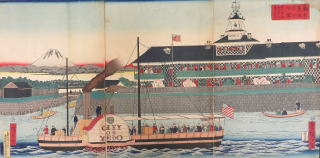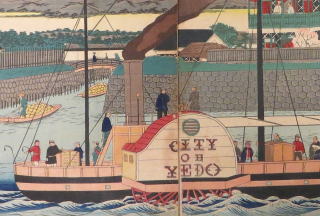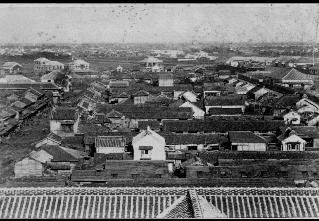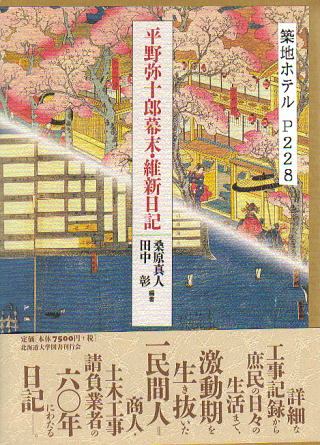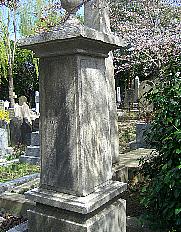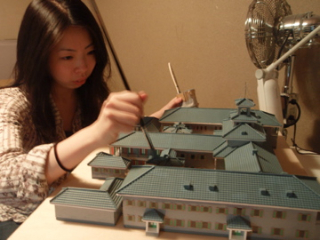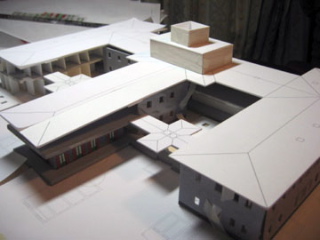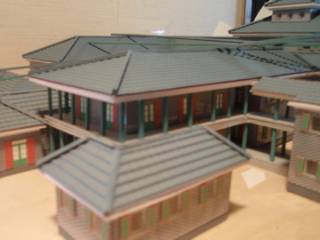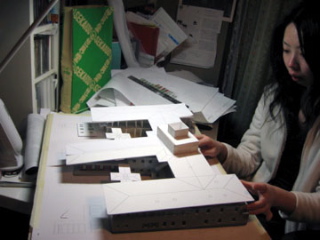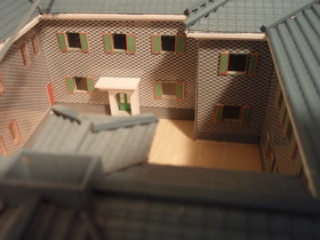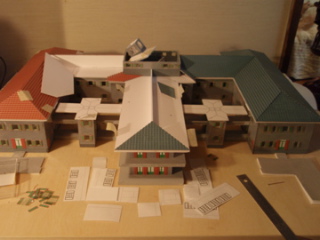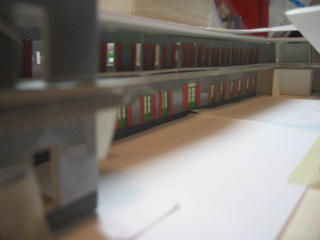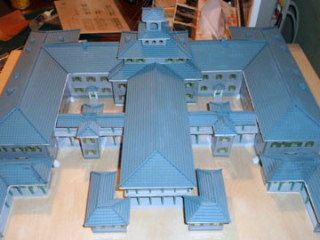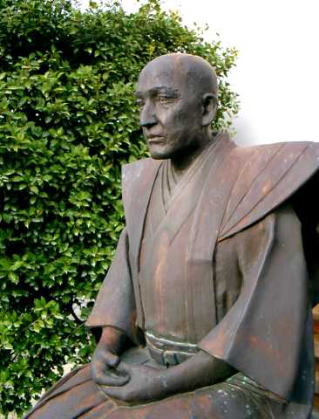
▲高井鴻山像 (高井鴻山記念館入口)
長野県小布施町の高井鴻山は豪農商・画家・学者として知られる人物である。晩年の北斎が江戸から4回小布施を訪れてたくさんの絵を残したのも、鴻山が招いたからである。いま高井鴻山の屋敷をそのまま使った記念館に入ると、中庭に北斎のために建てた離れのアトリエ「碧漪軒・へきいけん」(い…は、さんずい+ケモノヘン+奇=なみ)が残されている。
|
Statue of Kozan Takai (At the Entrance of Kozan Takai Memorial Museum)
Kozan Takai of Obuse, Nagano Prefecture, was known as a wealthy farmer,
painter, and scholar. In his later years, Hokusai Katsushika visited Obuse
and left many paintings because he was invited by Kozan. If you enter the
memorial museum, which is housed in Kozan Takai's mansion, you will find
a separate studio called "Hekiiken" built for Hokusai in the
courtyard.
|
|
小布施の高井鴻山が幕末に松代藩に提出した「船会社設立案」建議書が町教育委員会に残る。
「信越の富豪が結社して船会社を作り外国交易を行なえば、地域の物産振興、富国強兵につながる国民利福を図ることとなる」
「船はとりあえず官船を借用し、米人ウェンリイ(ヴァン・リード)の指導を受けて操船・交易の指導をしてもらう・・・」
「これは小栗上野介から示唆を得たもの」
であった。
|
Kozan Takai of Obuse submitted a proposal for the establishment of a shipping
company to the Matsushiro clan at the end of the Edo period, and the proposal
remains in the town.
The proposal reads,
"If the wealthy people of the Shin-etsu area join together to form
a shipping company and engage in foreign trade, it will promote the local
products and benefit the people, leading to a wealthy nation and strong
military."
"For the time being, we borrow a government ship and receive guidance
from Van Reed, an American, on ship operation and trading..."
"This was suggested by Kozukenosuke Oguri." |
慶応四年1月小栗上野介が勘定奉行を罷免されたためこの案はそのまま日の目を見ずに終わったが、そのことを悲しんだ鴻山は、幕府解散に際して会計総裁に任じられた大久保一翁(忠寛)から、至急江戸へ出てきて手を貸してほしいという招きに応じないで、代りの使者を駿河台の小栗屋敷へ送って挨拶をさせている。
「小栗上野介がいない江戸へ行っても、何ほどのことがあろうか」と受け止めている高井鴻山の落胆が痛いほど見えてくる。
【参考書籍】 山崎實著『高井鴻山物語』『続高井鴻山物語』・「船会社の提案書」は小布施町教育委員会蔵/『小栗忠順従者の記録』村上泰賢著
|
In January of 1868 (Keio 4), Kozukenosuke Oguri was dismissed from his
post as an accountant, and this proposal never came to light.
Konzan was saddened by this and, when he was invited by Ichio Okubo (Tadahiro),
who had been appointed as the treasurer at the fall of the Tokugawa Shogunate,
to come to Edo immediately and lend a hand, he declined it and instead
sent a substitute messenger to the Oguri residence in Surugadai, Edo to
greet him.
We can painfully see the disappointment of Kozan Takai, who was thinking, "What good would it do to go to Edo without Kozukenosuke Oguri?"
(Reference Book)
"Kozan Takai Monogatari" and "Kozan Takai Monogatari #2"
by Minoru Yamazaki
"Proposal for a shipping company," owned by Obuse Town Board
of Education
“The Record of Tadamasa Oguri’s Follower” by Taiken Murakami |
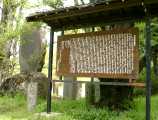 |
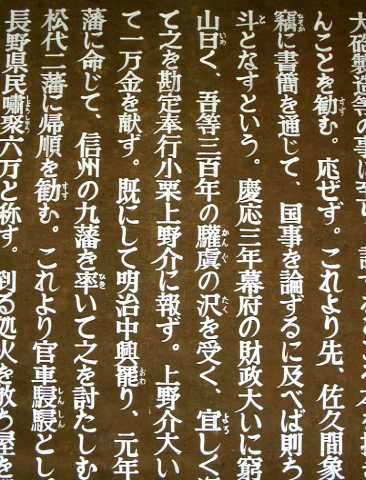 |
|
▲高井鴻山頌徳碑(左)と解読板(右)
北斎の天井絵「鳳凰」で名高い岩松院の境内の頌徳碑には、小栗上野介の名も刻まれている。
頌徳碑文中の小栗上野介→→
鴻山と小栗上野介のつながりが再確認され、いま小布施の人々は小栗上野介の業績についての関心が高い。
(頌徳碑-石碑は大正6年4月建立。日下部鳴鶴の書)
|
▲ Praising Monument to Kozan Takai (left) and deciphered board (right)
The name of Kozukenosuke Oguri is inscribed on the monument in the precincts
of Ganshoin Temple, which is famous for Hokusai's ceiling painting "The
Phoenix."
Kozukenosuke Oguri in the text of the monument ⇒
The connection between Kozan and
Kozukenosuke Oguri has been reconfirmed, and now the people of Obuse
are highly interested in the achievements of Kozukenosuke
Oguri.
(The Praising Monument to Kozan Takai, a stone monument, erected in April 1917. Calligraphy by Meikaku Kusakabe) |
高井鴻山と小栗上野介
小栗上野介は慶喜に罷免され、「帰農土着願」の許可を得て権田村に移る直前に、彰義隊の渋沢成一郎(喜作)が訪ねてきて彰義隊の隊長に着くよう依頼されるが、断っている。
主戦論を唱えながらなぜ、と言われるところだが、「将軍が立ち上がらない以上、大義名分のない戦はしない」といって断った。(by蜷川新「維新前後の政争と小栗上野の死」) 儒学では、「主君に三度諫言して之を容れざれば、之を去る」と説いていて、これほど言っても聞き入れない主君はこちら(家臣)から去る、と教えている。俗に言えば慶喜に愛想を尽かした、この人では戦っても無駄になる、という気持ちであろう。
単純に勝海舟は恭順論の平和派、抗戦を主張した小栗上野介は主戦派と決めつけるのは早計で「だから西軍に殺されて当然」と受け取られる恐れがある。
小栗上野介は 渋沢にこうも言っている 「(政権交代後に、)もし強藩が互いに勲功を争い内輪もめとなって群雄割拠するようなら、主君を奉じて天下に檄を飛ばすつもりはある」 として
「三百年に亘って施した徳川家の恩沢をまだ忘れない者も多くいるであろうから・・・。またそのようなこと(群雄割拠)がなければ自分は前朝の頑民として田舎で世を送るつもり…」
・筆者(村上泰賢)は以前から「恩沢を忘れないもの」としてこの時小栗上野介が誰をイメージしていたのか課題としていたが、岩松院境内の高井鴻山の頌徳碑に
「吾ら三百年の驩虞(かんぐ)の沢を受く、宜しく資産を挙げて以て危急を救うべし・・・」(驩虞(かんぐ)の沢=喜び楽しめた恩沢=300年間争いのない幕府政治のお陰で楽しく暮らせた)
とあることこそ小栗上野介のイメージを体現した人物の言葉と理解した。
江戸ー北信小布施と離れていながら、互いに心を通わせて、国事に心を痛めていた人が居たことを物語る石碑、と言えよう。 |
Kozan Takai and Kozukenosuke Oguri
Kozukenosuke Oguri was dismissed by Yoshinobu Tokugawa and, just before
moving to Gonda Village with the shogunate's permission of his "Application
for Returning to Farming," Seiichiro Shibusawa of the Shogitai came
to visit him and asked him to become the commander of the Shogitai. However,
Oguri refused the request.
He may be questioned why he, who advocated the idea of a major war, decided
against the request, but he said to Shibusawa that "I would not fight
a war without a cause as long as the shogun did not stand up."
(Ref. “Political Strife Before and After the Meiji Restoration and the
Death of Kozukenosuke Oguri” by Arata Ninagawa)
Confucianism teaches that, if the lord does not listen to you even after
you have admonished him three times, you should leave him. In layman's
terms, you probably felt that you had run out of love for the lord and
that it would be futile to fight with him.
It is too early to simply assume that Kaishu Katsu was a pacifist who believed
in reverence, while Kozukenosuke Oguri, who insisted on fighting, was a
warrior. If we assume so, we may be perceived as saying that Oguri deserved
to be killed by the Western forces.
Kozukenosuke Oguri also said to Eiichi Shibusawa, "If (after the change
of government) powerful clans fight each other for merit and become divided
into groups, I will send a message to the world in the name of my lord.
There are many who have not forgotten the benefits of the Tokugawa family
over the past three hundred years.... And if there are no such conflicts,
I will live out my life in the countryside as a stubborn citizen of the
previous dynasty...
I, Taiken Murakami, have long been trying to figure out who Kozukenosuke
Oguri imagined as "the one who he never forgets the benefits of"
for a long time. However, I found the monument to Kozan Takai in the precincts
of Ganshoin Temple that read as follows. "We have received three hundred
years of exchange of councils, and we should raise our assets to save ourselves
from danger..." At that moment, I realized that these were the words
of a man who embodied the image Kozukenosuke Oguri had.
This is the very stone monument that tells us that there were men who were
in touch with each other and cared about the affairs of the country despite
being far away from Edo and the Hokushin area (northern Nagano prefecture). |
高井鴻山の墓
小布施町祥雲寺(小布施堂の少し東)境内にある
戒名 「耕文院泰賢鴻山居士」
…とある。奇しくも道号泰賢とは、(このページの制作者村上泰賢と同名で)ありがたいご縁。
|
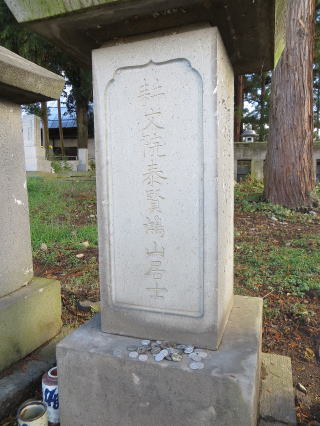 |
Tomb
of Kozan Takai
It is located In the precincts of Shounji Temple in Obuse Town (a little
east of Obusedo).
Posthumous Buddhist name: "Kobun-in Taiken Kozan Koji" ...is
written. Coincidentally, it has the same name as the creator of this Web
site, Taiken Murakami, for which I'm grateful. |
ヴァン・リード
オランダ系アメリカ人。ハワイ王国総領事の資格で慶応2年に来日し、横浜93番地に住んで貿易業務を行っていた。この図では「ウェンライト」、ほかに「ウェンリイ」と書かれることもある。
生麦事件の時、薩摩藩士に斬られたリチャードソンたちより早くに島津久光の行列に出会っていたが、リードは日本の習慣をよく理解していて下馬し脱帽して道端によけたのでトラブルにならなかった。 |
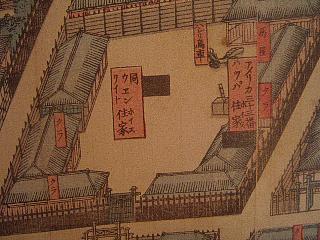
▲ヴァン・リードの住居 「横浜全図」より
▲Van Reed's Residence in "Yokohama Map" |
Van
Reed
Dutch-American. He came to Japan in 1866 (Keio 2) with the status of Consul
General of the Kingdom of Hawaii, and lived at 93 Yokohama, where he was
engaged in trading. In this chart, he is written as "Wenwright,"
and sometimes as "Wenlii" in other occasions.
At the time of the Namamugi Incident, he met Hisamitsu Shimazu's procession before Charles Lennox Richardson and his men, who were cut down by the Satsuma clan. However, Reed understood Japanese customs so well that he dismounted, took off his hat, and moved to the side of the road, causing no trouble. |
